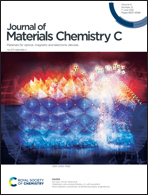MoS2 nanosheets chemically modified with metal phthalocyanine via mussel-inspired chemistry for multifunctional memristive devices†
Abstract
Memristive devices with in-memory computing functions have broad application prospects in the field of artificial intelligence. The development of memristive devices that integrate multi-functions of nonvolatile rewritable memory and biomimicking memristor activity requires the design and preparation of well-tailored memristive materials. In this contribution, MoS2 nanosheets (MoS2 NSs) were modified with polydopamine (PDA) through mussel-inspired chemistry, and then the metal phthalocyanine was covalently tethered onto their surface to form a two-dimensional MoS2-PDA–tBu4PcTiO nanomaterial with a sandwich structure. The fabricated electronic device with the Al/MoS2-PDA–tBu4PcTiO/ITO structure exhibits nonvolatile resistive memory characteristics in a large scanning voltage window and an ON/OFF current ratio of more than 103. Interestingly, the device exhibits history-dependent memristive characteristics in a small scanning voltage window. The potentiation and depression, as well as the “learning–forgetting–relearning” processes of a biological synapse, have been successfully emulated in this biomimicking memristor. This work is expected to provide new insights into the development of multifunctional memristive devices.



 Please wait while we load your content...
Please wait while we load your content...